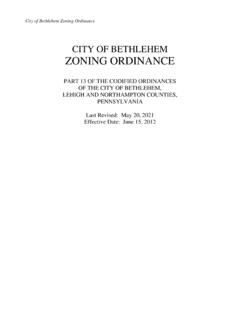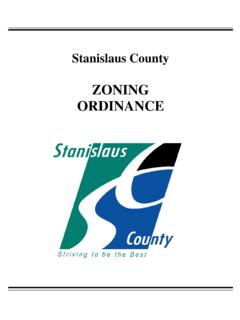Transcription of INDIANA CITIZEN PLANNER’S GUIDE - Indiana Planning
1 This booklet is one in a series of publications of the INDIANA Planning Association to be used as trainingmaterials for CITIZEN planners: plan commission members, board of zoning appeals members,neighborhood organizations, and CITIZEN committees. These materials are intended to supplementpublications such as Planning Made Easy and The CITIZEN s GUIDE to Planning . IPA s materials containinformation specific to INDIANA . Users of these guides are strongly encouraged to read other, moregeneral books on Planning and information contained in this booklet is intended for informational purposes onlyand is not to be considered legal PLANNER S GUIDEPart 8: Zoning Ordinanceby Timothy J. Porter, AICP &Teree L. Bergman, FAICPa publication ofThe INDIANA Planning Association,a chapter ofThe American Planning AssociationOther parts of the INDIANA CITIZEN Planner s GUIDE can be downloaded CITIZEN PLANNER S GUIDEPART 8: ZONING ORDINANCEIn this Part.. Historical perspective Purposes of zoning Zoning ordinance contents Developing the ordinance Adopting an ordinance Amending an ordinanceA zoning ordinance divides a jurisdiction of a local government intodistricts or zones and regulates land -use activities, the intensity or densityof such uses, the bulk of buildings on the land , parking, and other aspectsof land use.
2 The ordinance consists of a text and zoning map, both of whichmay be amended by the local legislative PerspectiveThe zoning ordinance is the most commonly used and oldest tool forimplementing land use policy in the United States. New York Cityadopted the nation s first zoning ordinance in 1906. This ordinance waslargely designed to decrease fire hazards by limiting building heightsand providing more space between buildings. In 1913 at the FifthNational Conference on City Planning , held in Chicago, the Committeeon Legislation report contained several model acts that would help shapeland development in the coming years: Establishing a city Planning department and giving it extra-territorial (three mile) Planning jurisdiction and the authority toregulate plans of lots; Empowering cities to create from one to four districts and to regulatethe heights of buildings constructed in each district; Authorizing the platting of civic centers; Authorizing the platting of reservations for public use withoutspecifying the particular public use; and Authorizing the establishment of building lines on any street ready is the secretof Henry FordIndiana CITIZEN Planner s GUIDE : Part 8 ~ Zoning ordinance Page2 The right of communities to adopt zoning ordinances regulating the useof land is well established in law.
3 The Standard State ZoningEnabling (SZEA) and the Standard City Planning Enabling Act (SCPEA),drafted by an advisory committee of the Department of Commercein the 1920s, gave states the right to adopt and enforce zoning 1921 INDIANA granted cities the authority to regulate the use of landand building bulk. In 1926, in Euclid v. Ambler Realty, the United StatesSupreme Court found that zoning is a valid exercise of police power, whichlocal governments use to protect the public welfare. The court wrote:The line the legitimate from the illegitimateassumption of power is not capable of precise delimitation. Itvaries with circumstances and conditions..the question ofwhether the power exists to forbid the erection of a building of aparticular kind or for a particular use, like the question whethera particular thing is a nuisance, is to be determined, not by abstractconsideration of the building or of the thing considered apart, butby considering in connection with the circumstances and thereality.
4 A nuisance may be merely a right thing in the wrongplace, like a pig in the parlor instead of the the courts have consistently upheld the right of communitiesto engage in Planning and to adopt regulations to implement those plans,judges have placed limits on this right. Regulations that go too far anddeprive a property owner of all economic use of the land are consideredunconstitutional takings of private property without just zoning ordinances set forth lists of permitted and prohibited the uses permitted were set forth in pyramid fashion; this is, ause allowed in a C-1 commercial zone is also allowed in a C-2 zone, andthose allowed in a C-2 are allowed in C-3 and so forth. Many zoningordinances were pyramidal, or cumulative, even between categories:residential uses were allowed in commercial districts, while bothresidential and commercial uses were allowed in industrial the 1950s and 1960s, many communities shifted to a strictseparation of land uses, a practice that more recently has been criticizedfor creating sterile, inconvenient environments.
5 In recent years localgovernments have tried innovative approaches to zoning, with varyingdegrees of success. Some of these approaches are discussed in this of ZoningA zoning ordinance is one of several tools used to implement comprehensiveplans. It has been common in INDIANA to confuse the zoning ordinance withthe comprehensive plan, but they are not the same, and the distinctionshould be clear. The comprehensive plan is the GUIDE for future development;it sets forth the community s vision and its statement of land use Quiz: Is yourcommunity s zoningordinance cumulative? CITIZEN Planner s GUIDE : Part 8 ~ Zoning ordinance Page3 The zoning ordinance is a regulation designed to make the plan a commission members and/or staff should be able to explain the purposeof each zoning regulation in relation to its role in implementing thecomprehensive Code lists the following purposes for local zoning ordinances: Securing adequate light, air, convenience of access and safety fromfire, flood, and other danger; Lessening or avoiding congestion in public ways; Promoting the public health, safety, comfort, morals, convenience,and general welfare; Otherwise accomplishing the purposes of this chapter [Chapter 4 ofthe INDIANA Code, Local Planning and Zoning].
6 While some zoning regulations, such as limitations on building in floodplains and requirements for adequate setbacks and driveway access, arerelated to concepts of public health and safety, most fall under the broaderand less defined category of general welfare. Protection of propertyvalues, lower public costs, and enhancing the livability of residentialneighborhoods are primary has been a continuing debate about the extent to which zoningordinances may be used to accomplish aesthetic objectives. The Court upheld the right of communities to use zoning foraesthetics in a landmark 1954 decision, Berman v. Parker. Writing forthe court, Justice William O. Douglas stated:The concept of the public welfare is broad and it represents are spiritual as well as physical. Aesthetic aswell as is within the power of the legislature todetermine that the community should be beautiful as well ashealthy, spacious as well as clean, well balanced as well ascarefully patrolled.
7 In the present case, the Congress and itsauthorized agencies have made determinations that take intoaccount a wide variety of values. It is not for us to reappraisethem. If those who govern the District of Columbia decide thatthe Nation s Capital should be beautiful as well as sanitary, thereis nothing in the Fifth Amendment that stands in the to Daniel R. Mandelker in his book land Use Law, A clearmajority of courts hold that aesthetics alone is a legitimate governmentalpurpose in land use regulation. Most zoning ordinances containregulations that at least in part are aimed at aesthetics. Building setbackregulations, height limitation, landscaping requirements and signregulations all have broad purposes, but community appearance is oneof zoning ordinances should be consistent with the purposes stated inIndiana code, and most important, the ordinance is an implementationtool; it is not a 36-7-4-601 Quick Quiz: Is yourcommunity s zoning codeheavy on aesthetic value?
8 Is this a priority for yourcommunity? Should it be? INDIANA CITIZEN Planner s GUIDE : Part 8 ~ Zoning ordinance Page4 Zoning ordinance ContentsA zoning ordinance contains two elements: text and maps. The two partsare equally important, and both should be carefully zoning maps should be as clear as possible, so that staff and citizenscan easily determine the zoning classification for a particular piece ofproperty. Some communities draw the official zoning map on auditor s platmaps, so that each property is easily identified. If a base map other than aplat map is used, it is a good idea to use clear features, such as streets,clearly defined property lines, or railroad tracks, as zoning boundaries. Thedrawback to using plat books is that there are large numbers of maps foreach community, and overall patterns of zoning are difficult to see. Inthese cases it is helpful to have an unofficial overall community map fordisplay and reference, in addition to the official zoning maps in the platbooks.
9 A small map, x 11" or 11" x 17" is useful as a quick reference forthe public, board members, and elected generally show each district as a different color or hatched color is used, the following color scheme is generally used and accepted byplanners. Yellow to orange should be used for residential districts. Theleast dense residential should be the lightest yellow, and the most denseshould approach orange. Commercial districts are generally a variety ofreds. The most intense commercial district should be the darkest districts are generally purple or grey. Recreational andagricultural districts are Information Systems (GIS) make preparing, maintaining,viewing, and printing zoning maps much easier. For communities thathave the capability of producing such maps, electronic mapping systemsare desirable. These can be printed at various scales, and maps of specificselected areas can be community s zoning ordinance text is different, as it should be.
10 Whilecommunities may have similarities, no two are exactly alike. Goals andobjectives are not identical, and their plans (if prepared properly) are uniquelysuited to the local context. Different communities also have different attitudestoward land use regulation. Zoning ordinances vary greatly in the amountof detail and sophistication. Tools that are important in one communitymay not be suitable in common complaint about zoning is that it is complicated. While simplicityis desirable, it is not possible to have an ordinance that is comprehensiveand effective in implementing land use policy and is also short and use issues are complex, and by necessity, the ordinances that regulateland use are also complex. Nevertheless, there are things communitiescan do to make the ordinances more Quiz: Think aboutthe zoning map in yourcommunity. Is it easilyaccessible? Is it easy toread and understand? INDIANA CITIZEN Planner s GUIDE : Part 8 ~ Zoning ordinance Page5 ordinance texts should be written clearly.




